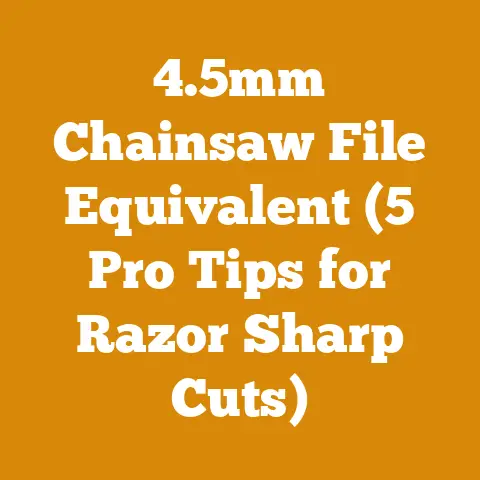Echo Bar Guide: Choosing Compatible Bars for Your Saw (Pro Tips)
Echo Bar Guide: Choosing Compatible Bars for Your Saw (Pro Tips)
I understand – life is a whirlwind. Between work, family, and everything else, finding time for hobbies like woodworking or even just keeping your property tidy can feel like a Herculean task. But when that firewood needs chopping or a fallen tree needs clearing, you need to be ready. And that means having the right chainsaw bar.
Choosing the right chainsaw bar for your Echo saw might seem like a simple task, but trust me, it’s a critical decision that can dramatically impact your saw’s performance, safety, and longevity. I’ve seen firsthand the frustration (and sometimes the danger) that comes with using an incompatible bar. This article is my attempt to make the process crystal clear, packed with pro tips, and, most importantly, geared toward helping you make the best choice for your specific needs and budget.
Understanding the Importance of Bar Compatibility
Before diving into the specifics, let’s address the elephant in the room: why does bar compatibility matter so much? It all boils down to these crucial factors:
- Safety: An improperly fitted bar can lead to chain derailment, kickback, and other hazardous situations. A loose or ill-fitting bar puts undue stress on the saw’s drive system, significantly increasing the risk of accidents.
- Performance: A compatible bar ensures proper chain tension, lubrication, and smooth cutting action. Using the wrong bar can result in poor cutting performance, increased vibration, and accelerated wear and tear on your saw.
- Longevity: The right bar minimizes stress on the saw’s engine and components, contributing to a longer lifespan. Conversely, an incompatible bar can cause premature failure of the saw’s bearings, clutch, and other vital parts.
I remember one time when I was helping a friend clear some storm damage. He tried to use a bar that was slightly too long for his saw, thinking it wouldn’t make much difference. Within minutes, the chain kept slipping off, and the saw was vibrating so violently it was almost impossible to control. We quickly realized the danger and switched to the correct bar. The difference was night and day – the saw ran smoothly and efficiently, and we were able to finish the job safely.
Decoding Echo Chainsaw Bar Specifications
To choose the right bar, you need to understand the key specifications:
- Mounting Pattern: This refers to the shape and size of the bar’s tang (the part that fits into the saw). Echo, like other chainsaw manufacturers, uses specific mounting patterns for different saw models. Using the wrong mounting pattern will prevent the bar from fitting securely.
- Bar Length: Measured in inches, bar length determines the maximum cutting diameter. Choosing the right length depends on the size of the wood you’ll be cutting. A longer bar allows you to cut larger logs, but it also requires more power from the saw.
- Chain Pitch: This refers to the distance between the drive links on the chain. The bar’s sprocket nose must match the chain pitch for proper engagement. Common pitches include 3/8″ low profile, .325″, and 3/8″.
- Chain Gauge: This refers to the thickness of the drive links. The bar’s groove width must match the chain gauge to ensure a snug fit. Common gauges include .043″, .050″, .058″, and .063″.
- Drive Link Count: This specifies the number of drive links required for the chain to fit the bar properly. This is determined by the bar length and chain pitch.
Finding Your Echo Saw’s Specifications
The easiest way to find your saw’s specifications is to consult the owner’s manual. If you don’t have the manual, you can usually find it online on the Echo website. Alternatively, you can look for a sticker or engraving on the saw itself, often near the bar mounting area. The model number is key!
Pro Tip: Keep a digital copy of your owner’s manual on your phone or computer for quick reference. You never know when you might need it.
Echo offers a variety of bar types, each designed for specific applications:
- Standard Bars: These are the most common type of bar, suitable for general cutting tasks like felling small trees, limbing, and bucking firewood.
- Hard Nose Bars: These bars have a solid, hardened nose, making them more durable and resistant to wear. They are often preferred for heavy-duty applications like cutting hardwoods or working in abrasive conditions.
- Sprocket Nose Bars: These bars have a sprocket at the tip, which reduces friction and improves cutting speed. They are often used by professionals for high-volume cutting.
- Carving Bars: These bars are designed for intricate carving work, featuring a narrow profile and a small radius tip.
Bar Features to Consider
Beyond the basic types, consider these features:
- Replaceable Sprocket Nose: Allows you to replace the sprocket nose when it wears out, extending the life of the bar.
- Lubri-Dam: A feature that helps retain oil on the bar and chain, improving lubrication and reducing wear.
- Inertia-Rated Bars: Designed to reduce the risk of kickback, these bars are often required for certain types of cutting tasks.
Compatible Bar Lengths for Common Echo Chainsaw Models
To make things even easier, here’s a table showing compatible bar lengths for some common Echo chainsaw models. Always double-check your owner’s manual for the most accurate information.
| Echo Chainsaw Model | Compatible Bar Lengths (inches) | Common Applications | | CS-271T | 12″, 14″ | Top Handle Arborist Saw. Limbing, Pruning 7 each saw model is slightly different, but here’s a general guideline:
| Chainsaw Model | Chain Pitch (inches) | Chain Gauge (inches) | Drive Link Count (Typical) | Recommended Bar Length (inches) |
|---|---|---|---|---|
| CS-310 | .375 (3/8) | .050 | 52 | 14-16 |
| CS-352 | .325 | .050 | 56 | 16 |
| CS-400 | .325 | .050 | 66 | 18 |
| CS-490 | .325 | .050 | 72 | 20 |
| CS-590 Timberwolf | .325 | .058 | 72 | 20 |
| CS-620P | .375 (3/8) | .058 | 72 | 20 |
| CS-2511TES | .375 (3/8) Low Profile | .043 | 60 | 12 |
| CS-271T | .375 (3/8) Low Profile | .050 | 45, 52 | 12, 14 |
Important Note: The drive link count can vary slightly depending on the specific bar manufacturer. Always double-check the bar’s specifications before purchasing.
- Authorized Echo Dealers: This is the best option for ensuring you get genuine Echo parts and expert advice. Dealers can help you select the right bar for your saw and provide installation and maintenance services.
- Online Retailers: Online retailers like Amazon, eBay, and chainsaw parts suppliers offer a wide selection of Echo bars at competitive prices. However, be sure to verify the seller’s reputation and read customer reviews before making a purchase.
- Hardware Stores: Many hardware stores carry a limited selection of Echo bars. This can be a convenient option if you need a bar quickly, but the selection may be limited.
Cost Considerations
The cost of an Echo chainsaw bar can vary depending on the bar type, length, and features. Here’s a general price range:
- Standard Bars: \$20 – \$50
- Hard Nose Bars: \$30 – \$70
- Sprocket Nose Bars: \$40 – \$100
- Carving Bars: \$50 – \$150
These are approximate prices and may vary depending on the retailer and specific bar model.
Pro Tip: Don’t be tempted to buy the cheapest bar you can find. Investing in a quality bar will pay off in the long run with improved performance, safety, and longevity.
Installation and Maintenance Tips
Once you’ve chosen the right bar, proper installation and maintenance are essential:
- Installation: Follow the instructions in your owner’s manual for installing the bar and chain. Ensure the chain is properly tensioned.
- Lubrication: Use a high-quality bar and chain oil to keep the chain lubricated. Check the oil level frequently and refill as needed.
- Cleaning: Regularly clean the bar and chain to remove sawdust and debris. Use a wire brush to clean the bar’s groove and oil holes.
- Sharpening: Keep the chain sharp by using a chainsaw file or a chain grinder. A dull chain will put extra stress on the bar and saw.
- Inspection: Regularly inspect the bar for wear and damage. Replace the bar if it is bent, cracked, or excessively worn.
I once neglected to properly clean my chainsaw bar after a particularly dirty job. Sawdust and debris built up in the groove and oil holes, preventing proper lubrication. The bar quickly overheated and started to wear out prematurely. I learned my lesson the hard way – regular cleaning is crucial!
Troubleshooting Common Bar Problems
Here are some common bar problems and how to troubleshoot them:
- Chain Slipping Off: This can be caused by an improperly tensioned chain, a worn bar, or an incompatible chain. Adjust the chain tension, inspect the bar for wear, and ensure the chain is the correct size and pitch.
- Poor Cutting Performance: This can be caused by a dull chain, a worn bar, or improper lubrication. Sharpen the chain, inspect the bar for wear, and check the oil level.
- Excessive Vibration: This can be caused by a bent bar, a loose chain, or worn bearings. Inspect the bar for damage, adjust the chain tension, and have the saw’s bearings checked by a qualified technician.
- Bar Overheating: This can be caused by improper lubrication, a dull chain, or cutting hardwoods. Check the oil level, sharpen the chain, and avoid forcing the saw when cutting hardwoods.
Budgeting for Chainsaw Bar Replacement
Chainsaw bars, like any tool component, have a lifespan. How long they last depends on usage, maintenance, and the type of wood you






